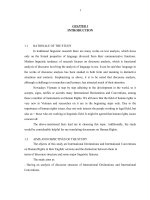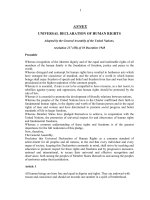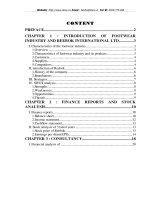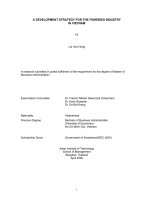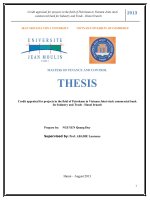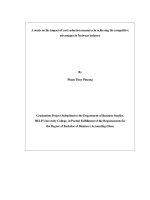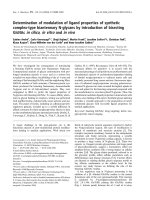introduction of footwear industry and reebok international ltd
Bạn đang xem bản rút gọn của tài liệu. Xem và tải ngay bản đầy đủ của tài liệu tại đây (1.38 MB, 20 trang )
Website: Email : Tel (: 0918.775.368
c o n t e n t
preface........................................................................................2
Chapter 1 : introduction of footwear
industry and reebok international ltd..............3
I. Characteristics of the footwear industry........................................................3
1.Overview ...................................................................................................3
2.Characteristics of footwear industry and its products...............................3
3.Customers..................................................................................................4
4.Suppliers.....................................................................................................4
5.Competitors................................................................................................4
II. introduction of Reebok.................................................................................6
1.History of the company.............................................................................6
2.Brandnames ...............................................................................................6
III. Strategies.....................................................................................................7
IV. SWOT analysis...........................................................................................8
1.Strengths ...................................................................................................8
2.Weaknesses................................................................................................8
3.Opportunities.............................................................................................9
4.Threats.......................................................................................................9
Chapter 2 : Finance reports and stock
analysis.....................................................................................10
I. Finance reports............................................................................................10
1.Balance sheet...........................................................................................10
2.Income statement.....................................................................................12
3.Cashflow statement..................................................................................13
II. Stock analysis of 3 latest years ..................................................................13
1.Stock price of Reebok..............................................................................13
2.Earnings per share(EPS)..........................................................................14
Chapter 3 : consultancy.................................................18
I. Financial analysis of ...................................................................................20
Financial analysis of Reebok
preface
Human have so many wants and needs and they always try to find some
ways to satisfy themselves. As a rule, Investors never keep money in their hand
but not invest them in market. It is the reason why so many people are
interested in analysing financial data, stock price of some company in order to
decide whether they should risk their money or not.
Before the year 2000, people seemed to be attracted in some high
technology industry to invest due to its high growth rate. But after the collapse
of some Bigs such as World.com, people tend into investing in some traditional
industry or safety industry more and more.
In order to understand profoundly the subject “ Finance accounting”, we
- the group 4
th
of A2 FBA K38 - have chance to research on Reebok company
under the guide of Professor Master Nguyen Thuc Anh. As requested, we have
analysed some data and index of the company’s financial state and stock price
in order to give some advice for investors who interest in buying RBK stocks. In
fact, after one and a haft month devoting our all efforts to study Reebok
company in particular and other companies in general, we have gained so many
useful things and experience. However, it is our first time to do that kind of
reseach and due to our unexperienced knowledge we may not avoid making
some mistakes. Therefore we highly appreciate to receive the comment from all
of you, especially from out professor Master Nguyen Thuc Anh.
Thank you for paying time to us.
Hanoi, 12/2002
Group 4
th
- A2 QTKD K38
Group 4
th
- A2.FBA.K38
2
Financial analysis of Reebok
Chapter 1 : introduction of footwear industry
and reebok international ltd
I. Characteristics of the footwear industry
1. Overview
Sales picture of footwear industry over the past couple of years has been
gloomy as a result of a glut of shoes store, gross oversupply and a general trend
toward “ brown leather shoes”. These are the primary culprits causing the loss
or none-profit overall the industry. However, business finally seems to be
improving now and in some coming years, promising a great potential for
companies in the industry.
This kind of the industry is very sensible to variations of the market and
it is also a seasonal business. So it requires all producers to be able to quickly
react to new market demand, develop product range. Furthermore, the
characteristic of the shoe-business can be indentified with entertainment
industry, where the product have short-life cycles and success depends on what
is flashy and stylish.
Today’s athletic shoes market is a mixture between fashion and
technology. So if a commpany wants to make a competitive distintion, it should
have create a fashionable image for itself.
2. Characteristics of footwear industry and its products
This industry is controlled by the large five: Nike (with market capture of
11,4 B $ up to Oct of the year 2002), Reebok ( with market capture of 1,5 B $),
Converse, LA Gear,Striderite so this is a concentrated industry since the “big
five” sets the trends. The athletic shoe wear industry is also an unique one in the
way it is market driven instead of product driven. That means every reaction of
the customers is noted by the producers and they will supply customers with
satisfactory products.
In this industry producers are likely to diversify their range of products
easily since customers’ needs seem to be related to each others. Men's apparel
and accessories marketed can push others needs of customers of products
ranging from golf apparel, leather jackets and sweaters to activewear and
swimwear.
The threat of substitude products is low since this industry is a mixture
between fashion and technology and only producers who have created the fame
and fashionable image can sell goods. Futhermore, the industry is upgrading the
products frequently to cope with flashy fads and the hottest fashion so there are
not too many close substitude products to athletics shoes. However, some
multipurpose shoes such as “ cross trainers” may be a possible substitude threat
to the current highly diversified range of athletic shoes on the market.
Group 4
th
- A2.FBA.K38
3
Financial analysis of Reebok
3. Customers
It is obvious that in the footwear industry there are many kinds of
customers who have different tastes and income. Therefore, all producers need
to supply a wide range of products in order to suit with every demand of the
customers.
Targeted customers of companies in this industry are women who use
walking shoes and also males between the ages of 16 and 25, and a children's
line targeted to boys and girls between the ages of 5 and 12.
Besides those customers companies which operate in the footwear
industry are designed to meet the demands of specific consumer types: image
and fashion conscious athletes, sports and fitness enthusiasts, and casual
athletic shoe buyers. Students have also been a key purchasing group because
they are at the age forming their opinions about things. In general, a significant
portion of the spending will be done by people age 18 to 37.
As a whole, footwear industry is a field which can serves all kinds of
people. It makes the producers have a full range of customers and must have
their own division of market segment. The potential customers of this industry
are people between the age of 5-37 including children, women, men and
professional athletes with many different tastes. However, the bargainning
power of the customers is medium to low.It is because the purchase of the
customers is not concenrated in large volumes and products have difference
thanks to the difference among different brand name.
4. Suppliers
In this kind of industry, producers need many sources to produce their
products, including material, machines, technique and services such as online
marketing service, permisson-based mail marketing service....This input is
dominated by relative few companies. Therefore, the bargaining power of
suppliers is medium to high since the product is unique and the switching costs
are high. Futhermore, it is possible for producers (especially in foreign
manufacturing) to intergrate forwards into the industry’ s business (in overseas
market ) and become an opponent to companies in the footwear industry.
5. Competitors
Competition in this industry is quite strong, mainly among the “large
five” Nike, Reebok, Converse, LA Gear,Striderite and also among some
branches like Polo, Timberland, Adidas ...Each company has its own strategy
and customers but there is always a dispute among them. However, now, the
most serious threat of competition is NAFTA (North America free trade area).
This area allows all competitors compete equally and freely and it leads
companies to reduce their labor and manufacturing costs to maintain company’s
profitabilitty.
Competitors in the footwear field include a number of sports and fitness
footwear and apparel companies, such as Nike, Adidas, Fila, New Balance and
Group 4
th
- A2.FBA.K38
4
Financial analysis of Reebok
Skechers. Apparel competitors include numerous brands such as Nike, Adidas,
Rocawear, Ecko, Brand Jordan, FUBU, Mecca and ENYCE. Competition
among men's casual sportswear, golf apparel and footwear makers includes
Timberland, Clarks, Ecco, Mephisto, Bass, Bostonian, Merrell, Easy Spirit,
Nine West and Gabor Cole Haan, Tommy Hilfiger, Prada and Gucci.
Reebok and Nike are the principal players in the industry. Although Nike
has also experienced some rough times, revenue fell 8% in fiscal 1999...but it
has now moved back into a position where its gross margins are stronger than
its competitors. Nike’s products also includes athletic footwear, apparel,
swimsuit, leather goods and it is estimated that Nike capture 45% market share
in the industry while Reebok ‘s part is 15%-18% of the pie only. All in all,
Nike has more power to the market than others because they have righter
strategy, faster long-term growth, stronger industry position, greater
international exposure and better brand name management.
Besides Nike, there are many current competitors which can be threat of
any producer in this industry. We can mention to Timberland or Polo as
examples.The Timberland Company headquartered in Stratham, New
Hampshire, designs, engineers, markets and distributes premium quality
footwear, apparel and accessories for men, women and children. Timberland®
products are sold in the United States and internationally through independent
retailers, better-grade department stores and athletic stores, in addition to the
Company’s own retail locations.The most important product of Timberland is
Timberland Footwear. Timberland has enjoyed significant expansion of its
brand presence both domestically and abroad Timberland’s markets include
Europe, United States, Asia and Asia- Pacific regions. Total market capture of
Timberland up to Oct,2002 is 1.1B $.
Polo Ralph Lauren Corp is a leader in the design marketing and
distribution of premium lilfestyle product in 4 categories : apparel(which
includes extensive collections for men’s, women’s, childen’s clothing), home
(which offers coordinated products for the home, interior decor..), accessories
( which includes a broad range of products such as eyewear, jewelry, leather
goods..) and frangrance(which includes skincare products). It constitutes one of
the world’s most widely recognised families of consumer brands. Its main
markets are United States, Europe and Asia. In fiscal 2002, the company
estimates to have 1,1 B$ of wholesale which includes 6,3% wholesale net sales
comes from chirlren wear; 41,8% comes from menswear; 8,6% comes from
home; 8,7% come from fragrances; 9,4% comes from accessaries and 25,4%
comes from womenswear.
As we said above this kind of market is dominated by “the big five” so it
is difficult to penetrate the market and cope directly with these Bigs (Not to
mention the high capital requirements due to advertising, research and
development). Furthermore, the relationship between dealers and distributers is
tied up by internal relationship between distributors and producers. So it is
really a challengence to anybody who wants to join this field. In conclusion, the
Group 4
th
- A2.FBA.K38
5
Financial analysis of Reebok
threat of new entrants into the industry is low so in this industry there are not
many potential competitors.
II. introduction of Reebok
1. History of the company
In the 1890s, Joseph William Foster - a famous English runner - made
some of the first running shoes with spike in them and then Reebok’s United
Kingdom-based ancestor company was founded. By 1895, Foster was in
business making shoe by hand for top runners and with his sons, they developed
an international clientele of distinguished athletic.
In 1979, Paul Fireman, a partner in an outdoor sporting goods
distributorship, spotted Reebok shoes at an international trade show. He
negotiated for the North America distribution license and then introduced three
running shoes in the US market as foundation of Reebok USA, Ltd. At that
period, its original strategy was aimed at prestige and at high price. At $60, they
were the most expensive running shoes in the market.
In 1981, PLC a British wholesaler of footwear acquired 56%of the
common stock in exchange for $77.500 in cash. Fireman and PLC agreed that
neither party would sell its stock to third party.
In 1985, Reebok USA purchase Reebok Britain to form a single company
up to now. Since then, Reebok had many explosive steps to become a
multinational firm. Its structure includes 4 groups: Reebok international, USA;
Rockport company; Ralph Lauren Footwear and Greg Norman Collection.
Products of Reebok are now available in over 140 countries including 3 main
markets North America, Europe and Asia among them European market is the
largest one with many subsidiaries ranging from Italy, Austria, German to
Russia.
2. Brandnames
Reebok is now a global company engaged in the design and market of
sport and fitness products, including footwear, apparel and accessories as well
as the design and marketing of footwear and apparel for non-athletic, “casual”
use.
* The Reebok brand
The Reebok brand designs, produces and markets sports, fitness and
casual footwear, appareel and accessories that combine characteristiics of sport
and style. Products of company also include footwear and apparel for children
sold under the Reebok and Weebok brands. Nowadays, The way reebok
chooses to expand is implementing strategic licensing program in which its
technologies and/or trademark are licensed to third paties.
*Rockport company.
Group 4
th
- A2.FBA.K38
6
Financial analysis of Reebok
Rockport focuses on specially engineered comfort footwear for both men
and women. Its product line includes performance, casual and dress shoes. In
2001, Rockport concentrated on strengthening its men’product by introduction
of some new collections. Besides, it continues to use proprietary technology to
enhance women’s walking product and siged a license agreement for the
development of children’s footwear.
*The Greg Norman Collection.
Originally a golf product line, the Greg Norman Collection has grown its
line of men’s sportswear to include products ranging from leather jackets and
sweaters to activewear and swimwear. In addition, it offers belts, small leather
goods and hosiery product. In 2001, the Greg Norman Collection introduced
men’s golf apparel marketed under Reebok name, continuing to offer a line of
moisture management golf shirts under the trademark PLAYDRY.
*The Ralph Lauren Footwear Co., Inc.
Its product line features traditional classic with Polo Sport and Polo Jeans
brand names which is targeted to males between the ages of 16 and 25, and to
children between the ages of 5 and 12. The Ralph Lauren also offers dress and
casual silhouettes. Internationally, it has distributors in Japan, Canada, Central
America and Europe and its products are sold through top-tier retailers.
III. Strategies
Fireman has applied some right strategies that led to the amazing
performance of Reebok
First one Fireman chose to apply is a concentrated growth strategy. At
the beginning of the company, it used all resources to penetrate into fixed
market. By utilizing excellent marketing techniques and effective promotion
program, fireman introduced only 3 styles of running shoe in only U.S market.
Following this strategy, fireman started to apply a product development
strategy. At that moment, company had built up its reputation so it only
focused on some product line such as women’s aerobic shoe and tennis shoe –
its traditional strong point and deliver them on so many market in order to pro-
long product life cycle and attract satisfied customer to new products. For
example, when there was a sign of reduction in sales in U.S market, the same
product would be launched in South East Asia.
The third strategy is market development one. With large
diversification, fireman now concentrated growth on national and international
expansion. Also, he started to attract other market segments.
Finally, Fireman focused on horizontal integration. He set up
acquisition of similar firms operating in the same market. This could eliminate
potential competitors, provide access to new market, greatly expand operations
Group 4
th
- A2.FBA.K38
7
Financial analysis of Reebok
as well as improve company’s diversification of its product line. For instant, in
1986, Rockport company – a manufacturer of high performance walking shoe
was required or in 1987, Reebok purchased AVIA Group International – an
Oregon based athletic shoe ... This one greatly attributed to Reebok’s success.
Reebok was able to require distribution channel, technical knowledge, enhance
profits and finally create a favorable brand image of existing goods. Besides, it
launches many campaigns on advertising by having agreement with music and
sport stars, with National Football League (NFL) and The National Basketball
Association to remain its market share in comparison with Nike.
IV. SWOT analysis
1. Strengths
The internal strengs of Reebok are all of the following:
Firstly, company has an extremely strong financial position. Its growth
has been phenomenal. It has the highest growth rate from 1983 – 1987 and
since that sales has continued to increase, from $ 12.8 m in 1983 to more than $
1.8 b in 1989 and certainly, earning per share has increased. Furthermore,
Reebok has a high level of liquidity and operated with minimal long-term debt,
so it has financial resources available to invest into market niches.
Secondly, thanks to successful strategic acquisition of reputation
companies, it is able to market a wide array of show–wear and is more
diversified than any competitors. For example, Rockport is the most dominant
brand in the walking shoe and a clear market leader in the tennis shoe market.
In addition, with the longest history, the latest technology and prestige, Reebok
is considered good and fashionable brand.
Finally, Reebok’s top management is highly marketing oriented. This is
strength for company, especially this industry is market driven instead of
product driven.
2. Weaknesses
The weaknesses of Reebok include all of the following:
In the new reorganization, AVIA is no longer represented in group of
four operating company. It was allowed to pursue its own strategies including
aggressive competition with Reebok brand. This could cause internal tension
within cooperation.
On the other hand, due to managing style there is a conflict of interest in
the top management between Fireman party and someone. It leaded to the
resignation of Joseph Labonte - the former president and operating officer and
Mark Goldston – the former chief marketing officer who had managerial
experience in multibillion – dollar organization and in heavy marketing as
well as in advertising of consumer brand name. As a result, Fireman took the
position of chairman, president, and COF. That is an impossible task. The
Group 4
th
- A2.FBA.K38
8


